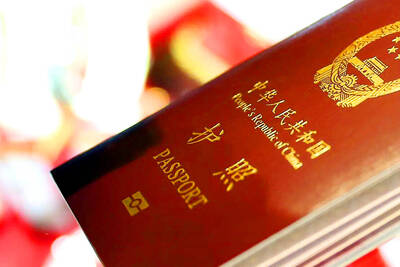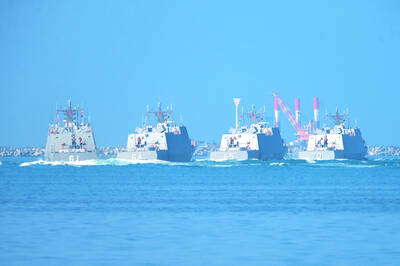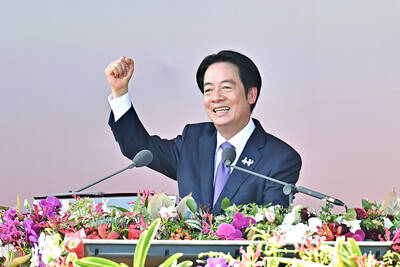Most people who own an iPhone, a Prius or a Nintendo Wii have never heard of Porite, but this small company outside Tokyo makes a crucial part of their toys’ vital organs.
Despite the ubiquity of the tiny copper bearings Porite churns out by the millions each day, orders all but dried up in September. Now shipments are down about 40 percent from last year, as consumers in the US and elsewhere rein in spending on sophisticated electronics.
With little to do, the company’s 400 employees spend their days sweeping and cleaning, and about a dozen contract workers have been let go.
The finance ministry announced on Wednesday that exports from Japan, the world’s second-largest economy, fell by a record 49 percent last month compared with a year earlier. It was the fifth consecutive month that exports have fallen. Shipments to the US fell 58 percent. Japan’s trade surplus was down 91 percent, to ¥82.4 billion (US$840 million).
Although the Japanese brands known worldwide have received more attention in the news, the bulk of the problems affecting Japan’s exporters are not at Toyota or Sony, both of which predict deep losses this year, but at small and midsize companies like Porite.
In a shift often overlooked even inside Japan, these virtual unknowns now account for about 75 percent of Japan’s manufacturing output and employ almost 90 percent of the sector’s workers.
In part because of the export slump, the country’s economy was 12.1 percent smaller in the last three months of last year than in the period a year earlier, putting Japan on course for its deepest, longest decline since World War II.
“Japan has taken a disproportionate hit in the economic downturn,” says Yasuo Yamamoto, senior economist at the consulting firm Mizuho Research Institute. “Japan’s exports are concentrated in the very sectors that have been hit the most in the economic crisis, like cars and electronics.”
Porite is an example of an increasingly important group of Japanese exporters that have found a niche in making the advanced inputs — like tiny bearings and micron-thin films and wafers — that make other companies’ products tick. Streamlined and focused, they bear little resemblance to the conglomerates that have long dominated Japanese industry.
“Because these companies aren’t household names, their emergence has been easy to overlook,” said Ulrike Schaede, a professor at the University of California, San Diego.
In fact, division of labor is developing on a large scale in Asia. Take the laptop, for example: Japan exports advanced materials and machinery tools to Taiwan and South Korea, which make microchips and other intermediate products to export to China, which puts together laptops to ship to the US.
Similarly, almost 75 percent of the parts that make up semiconductors are made in Japan, though the semiconductors themselves may be manufactured elsewhere, estimates by the Japanese trade ministry showed.
But that has made Japan’s export industries especially vulnerable to the global downturn. On top of a fall in direct exports to the US, Japan is exporting less to other Asian manufacturing centers like China, Taiwan and South Korea, as companies there scale back production.
Moreover, exports have been growing in importance for Japan. Overseas shipments have surged in recent years, fueled by a huge appetite for Japanese cars and gadgets among consumers in the US and elsewhere, while the domestic economy has stagnated.
Last year, exports made up 15.9 percent of Japan’s GDP, up from 9.8 percent a decade ago.
Even small companies like Porite rode the wave of globalization, opening factories in Taiwan, Singapore, Malaysia and Thailand — and, in 2002, Jefferson City, Missouri. Now, more than 70 percent of Porite’s sales come from outside Japan.

The Ministry of the Interior (MOI) is to tighten rules for candidates running for public office, requiring them to declare that they do not hold a Chinese household registration or passport, and that they possess no other foreign citizenship. The requirement was set out in a draft amendment to the Enforcement Rules of the Public Officials Election and Recall Act (公職人員選舉罷免法 ) released by the ministry on Thursday. Under the proposal, candidates would need to make the declaration when submitting their registration forms, which would be published in the official election bulletin. The move follows the removal of several elected officials who were

FOUR DESIGNATED AREAS: Notices were issued for live-fire exercises in waters south and northwest of Penghu, northeast of Keelung and west of Kaohsiung, they said The military is planning three major annual exercises across the army, navy and air force this month, with the navy’s “Hai Chiang” (海強, “Sea Strong”) drills running from today through Thursday, the Ministry of National Defense said yesterday. The Hai Chiang exercise, which is to take place in waters surrounding Taiwan, would feature P-3C Orion maritime patrol aircraft and S-70C anti-submarine helicopters, the ministry said, adding that the drills aim to bolster the nation’s offshore defensive capabilities. China has intensified military and psychological pressure against Taiwan, repeatedly sending warplanes and vessels into areas near the nation’s air defense identification zone and across

SENATE RECOMMENDATION: The National Defense Authorization Act encourages the US secretary of defense to invite Taiwan’s navy to participate in the exercises in Hawaii The US Senate on Thursday last week passed the National Defense Authorization Act (NDAA) for Fiscal Year 2026, which strongly encourages the US secretary of defense to invite Taiwan’s naval forces to participate in the Rim of the Pacific (RIMPAC) exercise, as well as allocating military aid of US$1 billion for Taiwan. The bill, which authorizes appropriations for the military activities of the US Department of Defense, military construction and other purposes, passed with 77 votes in support and 20 against. While the NDAA authorizes about US$925 billion of defense spending, the Central News Agency yesterday reported that an aide of US

NATIONAL DAY: The ‘Taiwan Dome’ would form the centerpiece of new efforts to bolster air defense and be modeled after Israel’s ‘Iron Dome,’ sources said President William Lai (賴清德) yesterday pledged to strengthen the nation’s air defense capabilities and build a “T-Dome” system to create a safety net against growing military threats from China. “We will accelerate our building of the T-Dome, establish a rigorous air defense system in Taiwan with multi-layered defense, high-level detection and effective interception, and weave a safety net for Taiwan to protect the lives and property of citizens,” he said in his National Day address. In his keynote address marking the Republic of China’s (ROC) 114th anniversary, Lai said the lessons of World War II have taught nations worldwide “to ensure that